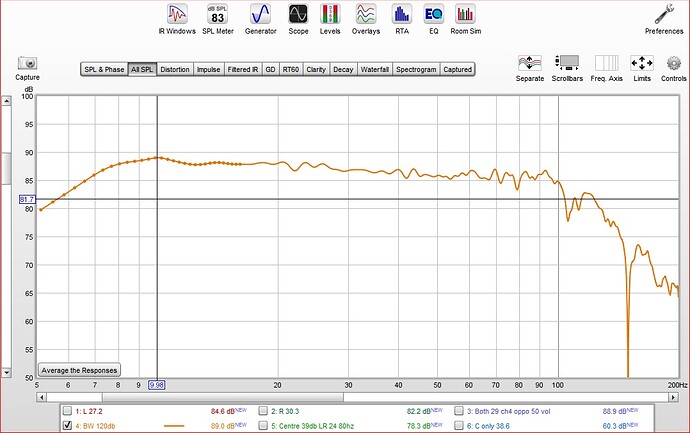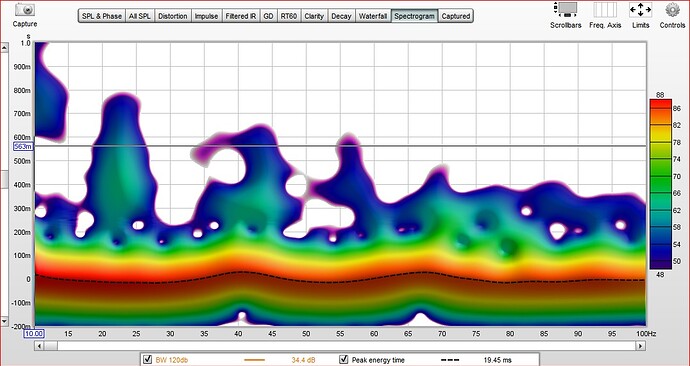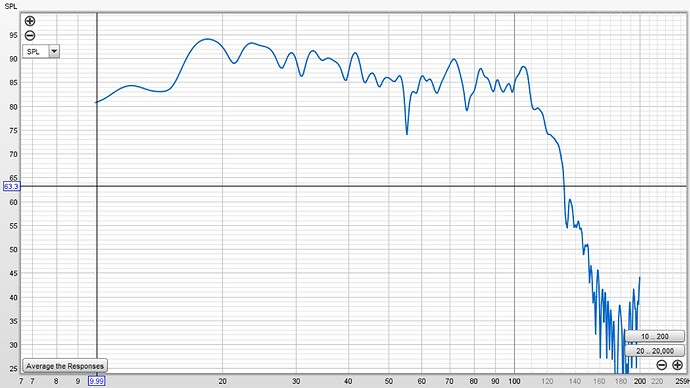So seat 2 is denoted in “blue” what is the color codes for the MLP and seat 3?
I am overcoming this “discrepancy” in output by varying the gain for each of the 3 subwoofers. For instance, the front left subwoofer gain knob which is nearer to the corner which increase output level due to boundary gains will be 9 o’clock while the right front subwoofer will have the gain knob set at 11 o’clock. The rear subwoofer with the smaller driver has the gain knob set at 10 o’clock. With the 3 subwoofers combined. The summation is greater than it’s parts and I’m glad that the combined reading is about the same as my speakers SPL readings. At modal frequency, human auditory is very tricky. The mind will tell you that it is not “loud” enough even though the SPL readings for the subwoofers are at about the same level as the speakers. This is why I mentioned that tuning output using familiar tracks becomes a necessity since we can no longer rely on just purely SPL readings here.
The challenge here for me is 3 subwoofers instead of 4 to cover all corners. The summation of the levels combined as one is the one we try to achieve but ARC measure one pair of subwoofers at a time instead of a combined readings like what Audyssey does. So instead of waiting for ARC to come out with such a feature, we have to improvise and use REW which allows all subwoofers to be playing at once. But REW graph response can only tell you so much…so have to try on some real time content to give those finishing touches.
I welcome members to experience it (even bass at all seats) when the covid situation improve.
This is a compromise to a certain degree. It really depends on what one try to achieve here. Perfect readings may not always translate well to actual listening experience so I urge everyone not to be too fixated on graph reading but use it as a tool to help you understand your room better and use it to make adjustments with your subwoofer or even speaker placement.
Black denotes MLP and pink denotes seat 3
That’s where the Harman or house curve come into the equation.
Bingo!
I can see why you prefer seat 3. ![]()
Actually that’s exactly what I’m highlighting to you.
The subwoofer at front right corner, is the one sub that is working extra hard (at 11 o’clock) over the other subs, because the one at the left , has a head start from boundary gains.
If u put a subwoofer in an open field for example, where there is no boundary gain. U increase levels on left sub and right sub simultaneously, the sub that is at 11oclock, will run out of headroom first going into distortion territory whilst the left sub, is probably still cruising at 9 o’clock amplifier volume
That’s something u need to consider because with HT, we normally crank up the bass for the LFE special effects channel that is 125db at reference. Couple that with re-directed bass from the mains and easily reference for LFE is 130db
At 9 o’clock amplifier on sub , I’m guessing you are using a lot of levels in digital domain, this is the second risky part because there is a very high possibility of clipping signals in the digital domain. I would push the levels on the amplifiers on the subs instead to increase the gain in the analog domain and reduce the volume in the digital domain
If u r using identical subs, gain matching will be the way to go… meaning all subs having to use the same amount of amplifier and running out of steam the same time…
It’s like “ Bu hua suan” to use the right subs to work so hard whilst the left sub is cruising… the entire system is then limited to the right sub that is at 11 o’clock. Because the moment the 11 o’clock subs run out of steam, distortion kicks in and left sub is still cruising with no distortion at 9 o’clock…. In such a scenario, although they are both capable similar subs, but the system is dragged down by the right sub running at 11 o’clock, so the moment the subs at 11 o’clock runs into distortion territory, one can no longer go past “x” master volume
Bro, u really analyse too much lar. Relax.
My goal is to achieve seat to seat consistency and not just one good seat. That’s too easy. The whole point of this post is for discussion and see if we can improve seat to seat consistency for bass. I’m merely sharing my thoughts and the approach however flawed it may be in your eyes.
When you have a flagship AVR and AV Processor like Lygndorf, Trinnov and StormAudio with those enhanced features like the ones you’ve mentioned, Life will be so much simpler. 
Ya actually it’s legit. These are gain optimisation techniques used by system integrators.
What we are measuring is at 72-76db plus, we will need to take into consideration what happens when the system is playing at 100db.
If we look at playing the system at mv-15, that means LFE channel will easily be handling levels at 115db. 130db -minus 15
But the good thing now is most content below 30hz has been butchered by the studios, so that’s really a plus point for headroom. It will be sufficient with the above approach
Good sharing bro on seat to seat variation. Just letting you know on a few other details u might want to look into in this process
Enjoy the journey !
Hope to see others share your approach/method u used to get a good seat to seat consistency. It can be a very simple approach or perhaps a piece of hardware that you’ve used to get it working?
Sadly other than tune traps and room dimension or multiple subs, don’t have. Not possible without any sacrifices
There are bound to be variation no matter how we look at it or whatever approach we take and something needs to take a hit in the process
If we are talking about consistency from 10 to 100hz…. Having all seats to have that consistency, can be achieved with EQ. But the end results will be unsatisfactory
This is one I have tried, 3 years ago, it uses the Geddes approach for multiple subs . It’s known as MSO
For those who are keen, can check this out as well. The software is free and the steps are provided
There is also a video on YouTube on how to do it. But I didn’t bother much with it as I have tried it and wasn’t really a fan of it
The approach focuses on minimizing the seat-to-seat frequency response variation in the bass region while simultaneously optimizing the response flatness at the main listening position.
You can have the variation reduced, by averaging with eq filters to reduce the variation. But in that process, one would also need to look at other factors like , timing, decay, headroom
One more thing for those looking into seat to seat consistency, is to have a look at the decay times for the bass frequencies
The approach above, focuses only on one aspect, which is the frequency response and sound pressure levels of a few given seats.
What was missed out in the consideration , is the time it takes for those given frequencies to decay. Because the decay times of the bass frequencies are independent of frequency response
Decay time is referring to “how fast the energy stops after playing that particular frequency “
So if you have a very flat or averaged frequency response from seat to seat, u will also need to ask the question, how fast those frequencies decay? Example will be, is the 65hz “c Note” from the piano still lingering around in the room? Whilst other 55hz “A note” has dissipated in energy?
So yes the other important aspect, is to try and make sure, the decay times are even across all seats, this aspect is equally important as getting a good frequency response that is even from seat to seat. iE:// How fast the energy decays
The above is what I have calibrated in the past, very good seat to seat consistency… but……
Zoom in to the decay…… a lot of it goes past 500ms, that means I had very good equal bass from seat to seat, but at 20,40,60hz, energy still lingering around in the room, in the process masking out details in the upper frequencies
Nice to have ? Resounding yes  . Beautiful graph? Yes
. Beautiful graph? Yes
Sounds good ? Ok ok. Could have been better
So one more area to look into as well, apart from distortion when it goes past “x” Master volume, that is the RT60 decay times
Hope that helps  and definitely share your journey
and definitely share your journey
Share with us how you place your dual subs. For those with > 2 subwoofers, you can also share with us how you place it.
C for me.
How does it perform for you? Any measurements or comments on the location you’ve chose?
The right and left subs smoothen the FR. There are dips and peaks at various frequencies for each sub. The summation of both subs is shown on the attached image before running Audyessy.
I am sure there are better placements for the subs but due to WAF, I have no other locations to place them but flank the both sides at the front.
Your dual SB3000 really digs “deep” with very good SPL. The 55Hz dip is sharp and narrow, probably will not be discernible. To fix this, it is either your move your seat or subwoofers but like you mentioned the latter is not a choice (due to WAF).
FWIW the 55Hz - 70Hz is where you get that chest-slamming bass. Judging from the graph, you should be fine, especially the deep bass portion.



